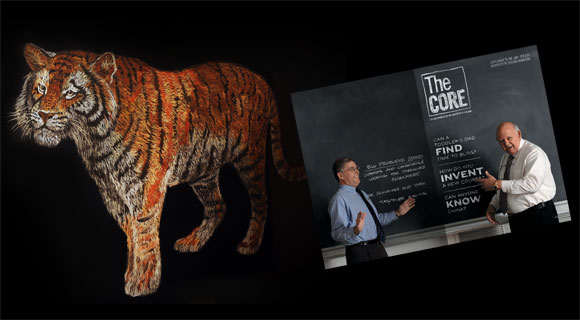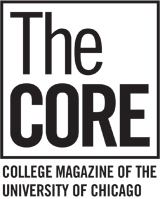
Letters
Tales of the chalkboard tiger
TIGER TRAIL
I saw your request for information about the tiger on the blackboard (“Blackboard Jungle,” Jan–Feb/11), and I may be able to provide some information about its “first” appearance. The tiger just appeared one morning on the blackboard in the seminar room in Searle that I was using as a temporary classroom (perhaps because Kent was under renovation at that time). It had already acquired a set of “saves” when I first saw it.
—Leon Stock, Emeritus
Professor of Chemistry
I’ve just read your article about the Chicago tiger, and I would like to point out that unfortunately, the symbol may not be the artist’s name, though it might mean that the artist is one of Asian descent or well-versed in Asian art. Tigers as portrayed in Chinese art (and perhaps Japanese and Korean) often have a “wang” symbol on their heads because the stripes resemble the three horizontal strokes in the symbol.
—Kai Leng
I was an undergraduate student working in Searle in 1983–84 and remember the tiger quite well and met a graduate student introduced to me as the artist. He was known colloquially to the undergraduates as “Jesus” because of his long hair and beard. I don’t know his name, but he was a senior graduate student by this time and so would have likely started five to eight years before this. It is also possible the graduate students were having fun teasing me on this; there was a fair amount of good natured ribbing and joking that went on in the Searle labs in those days.
—Mark Banaszak Holl, SB’86
I adored the tiger you mention in your article. One day in 1987 I noticed that someone had erased an entire top to bottom section in the middle of the tiger. I spent an entire weekend repairing the tiger back as closely as possible to match the original. The tiger deserved the attention and restoration. Even after I graduated college, but was still working on campus, I would occasionally visit the tiger. It was rumored in the 1980s to have been drawn by a graduate student of [Jack] Halpern’s in the late ’60s or early ’70s. But nobody knew the name of the artist.
—Suzanne Hessefort, AB’89
COURSE CORRECTION
The Jan–Feb/11 issue was about new courses (“Charting a New Course”). An interesting list is on page 15 (“Make It New”): baseball and culture, independent Catalan cinema, child poverty, and much delectable more. Funny, I didn’t see any courses with names like “What an educated person should learn from anthropology.” Likely each of those swell new courses is really a new publication about to be fostered or something otherwise on the agenda of the professor. Pity nobody has been asking for some time what a young person ought to be offered in college and making that happen.
—Ben Barkow, AB’61
What would Robert Maynard Hutchins say about Baseball and American Culture, 1840–Present and The Public and Private Lives of Insects and everything in between—except for Platonic Explorations?
—Irving E. Fasan, AB’47, JD’57
KING OF POP
I did not expect to see Michael Jackson’s name on your pages (“Bringing Up Baby,” Jan–Feb/11). I was excited—was the iconic entertainer to be the subject of a new course or book? Unfortunately, David Hoyt’s (AB’91) use of Mr. Jackson’s name was about promoting a tabloid-induced image of the man rather than a scholarly exploration of his music and cultural impact.
This is a university that rewards independent thinking, and it’s a shame that Mr. Hoyt felt the need to tarnish Mr. Jackson’s legacy by furthering a tired and false stereotype. I’ll remind him that Mr. Jackson was never convicted of any crime. I hope that Mr. Hoyt teaches his son to search for the facts and not listen to sensationalist reporting.
—Juliet Friedman, AB’99
GUILTY AS CHARGED
In your article “Blogroll, Please...” (Jan–Feb/11), the Becker-Posner blog is described as “Professors (Nobel Prize + District Court) = the most academic and rigorous blog in the blogosphere.” There’s just one problem with that description: Judge Posner is not, and never has been, a district court judge. Posner sits on the 7th Circuit Court of Appeals, as he has since his appointment by Ronald Reagan in 1981.
—Tyler Alfermann, AB’09
